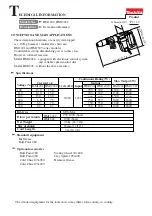
English
6
MAINTENANCE
WARNING: To reduce the risk of serious personal
injury, turn unit off and disconnect it from
power source before making any adjustments or
removing/installing attachments or accessories.
An accidental start-up can cause injury.
action, the blade moves forward during the cutting stroke in
addition to the up and down motion.
nOTE:
Metal or hardwoods should never be cut in
orbital action.
To Adjust the Cutting Action
• Move the orbital action dial
8
between the four cutting
positions: 1, 2, 3 and 4. Position 1 is straight cutting.
Positions 2, 3, and 4 are orbital cutting.
• The aggressiveness of the cut increases as the lever is
adjusted from one to four, with four being the most
aggressive cut.
Fig. G
8
Cutting
Different blade lengths are available. Use the appropriate
blade for the application. The blade should be longer than
1 1/2" (38 mm) and should extend past the shoe and the
thickness of the workpiece throughout the cut.
TOOl sPECiFiCATiOns
Maximum cutting depth
3/4" (19 mm)
Strokes per minute
0–3000
Hints for Optimum Use
Tips for general Usage
• Use a high speed for wood, a medium speed for
aluminum and PVC and a low speed for metals other
then aluminum.
Tips for sawing laminates
• As the saw blade cuts on the upward stroke, splintering
may occur on the surface closest to the shoe plate.
• Use a fine-tooth saw blade.
• Saw from the back surface of the workpiece.
• To minimize splintering, clamp a piece of scrap wood
or hardboard to both sides of the workpiece and saw
through this sandwich.
Tips for sawing Metal
• Be aware that sawing metal takes much more time than
sawing wood.
• Use a saw blade suitable for sawing metal.
• When cutting thin metal, clamp a piece of scrap wood
to the back surface of the workpiece and cut through
this sandwich.
• Spread a film of oil along the intended line of cut for
easier operation and longer blade life. For cutting
aluminum, kerosene is preferred.
Pocket Cutting (Fig. H, I)
A pocket cut is an easy method of making an inside cut. The
saw can be inserted directly into a panel or board without
first drilling a lead or pilot hole.
1. In pocket cutting, measure the surface to be cut and
mark clearly with a pencil.
2. Next tip the saw forward until the front end of the shoe
5
sits firmly on the work surface and the blade clears
the work through its full stroke.
3. Switch the tool on and allow it to attain
maximum speed.
4. Grip the saw firmly and lower the back edge of tool
slowly until the blade reaches its complete depth.
5. Hold the shoe flat against the wood and begin cutting.
Do not remove blade from cut while it is still moving.
Blade must come to a complete stop.
Fig. H
5
Fig. I









































